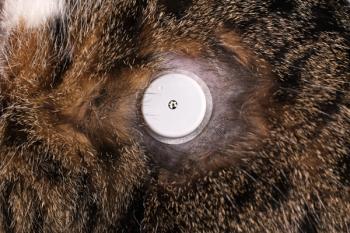
Testing for Addison's disease
Hypoadrenocorticism, or Addison's disease, results from failure of the adrenal glands to secrete glucocorticoids (primarily cortisol) and mineralocorticoids (primarily aldosterone).
Dr. J. Catharine Scott-Moncrieff lectured at the 2008 American College of Veterinary Internal Medicine Forum on diagnostic testing for canine hypoadrenocorticism. Here are some relevant points from that lecture:
Hypoadrenocorticism, or Addison's disease, results from failure of the adrenal glands to secrete glucocorticoids (primarily cortisol) and mineralocorticoids (primarily aldosterone). Most cases of hypoadrenocorticism are from primary adrenal failure, resulting in deficiency of usually both cortisol and aldosterone from the adrenal cortex. Rarely, Addison's disease may be due to pituitary dysfunction, resulting in a failure of ACTH secretion and pure glucocorticoid deficiency (secondary adrenal failure). In secondary hypoadrenocorticism, mineralocorticoid secretion is expected to be normal.
Cause
Because most cases of hypoadrenocorticism either don't result in a necropsy or are successfully treated, the underlying cause usually is not known in individual animals. Primary adrenal failure is suspected to be immune-mediated in most cases. Other causes of primary hypoadrenocorticism include granulomatous destruction or hemorrhagic infarction of the adrenal gland, adrenalitis, neoplasia, amyloidosis and necrosis.
Immune-mediated destruction of the adrenal gland may occur together with other immune-mediated endocrine disorders, such as hypothyroidism, diabetes mellitus and hypoparathyroidism. Destructive lesions in the hypothalamus or pituitary from neoplasia, inflammation or trauma may cause secondary hypoadrenocorticism. Idiopathic ACTH deficiency also may occur.
Primary adrenal failure may be caused by a number of drugs, including mitotane, trilostane and ketoconazole. Adrenal suppression caused by ketoconazole and trilostane is reversible in most cases, but adrenal failure caused by mitotane may be permanent.
Administration of glucocorticoid drugs may cause secondary adrenal failure. After corticosteroid administration (topical, oral or injectable), suppression of ACTH production from the pituitary gland occurs within a few days, resulting in secondary adrenal atrophy. How long the adrenal axis is suppressed depends on the potency and half-life of the administered glucocorticoid. Long-acting depot drugs are the most potent adrenal suppressants and can cause suppression for five to six weeks or longer.
Signalment
Seventy percent of dogs diagnosed with hypoadrenocorticism are female, and most are young to middle-aged (average being 4 to 5 years). The disease is heritable in the standard Poodle, Bearded Collie, Portuguese Water Dog and the Nova Scotia Duck Tolling Retriever. In these breeds, no obvious sex predisposition is evident. In the standard poodle, Portuguese Water Dog and Nova Scotia Duck Tolling Retriever, the disease appears to be inherited as an autosomal recessive trait. Incidence of hypoadrenocorticism in the Nova Scotia Duck Tolling Retriever is estimated to affect 1.4 percent of the population, while in the standard Poodle 8.6 percent in one study were affected.
History and physical exam
Clinical signs may be acute or gradual in onset, and they often wax and wane. Owners may not realize how long their dog has been ill until treatment results in a dramatic improvement in activity level. Because 85 percent to 90 percent of adrenal reserve must be depleted before clinical signs are observed, it may require a stressful event to trigger clinical illness. Clinical signs may be vague and rarely are pathognomonic. Anorexia, vomiting, lethargy/depression, weakness, weight loss, diarrhea, shaking/shivering, polyuria, polydipsia and abdominal pain may be observed. Most of these clinical signs can occur due to glucocorticoid deficiency alone.
If mineralocorticoids also are deficient, the clinical signs tend to be more severe, and polyuria, polydipsia, hypovolemic shock, collapse and dehydration often are present. Less common clinical signs include acute gastrointestinal hemorrhage and seizures due to hypoglycemia or electrolyte derangement. The physical examination may be normal or may reveal lethargy, weakness, dehydration, bradycardia, weak pulses, decreased capillary refill time and other evidence of hypovolemic shock.
Clinical pathology
Complete blood count may reveal a nonregenerative normocytic normochromic anemia, or the hematocrit may be increased due to dehydration. Eosinophilia, neutrophilia or lymphocytosis occurs in only 20 percent to 30 percent of dogs with hypoadrenocorticism, but lack of a stress leukogram in a dog with systemic illness is common.
A serum chemistry profile may reveal hyponatremia, hypochloremia, hyperkalemia, hypercalcemia and hyperphosphatemia. These changes occur due to aldosterone deficiency with a resultant failure of the kidneys to conserve sodium. This is accompanied by profound fluid loss, shift of potassium ions to the extracellular compartment, pre-renal azotemia due to decreased renal perfusion and hypovolemia. A mild to moderate metabolic acidosis also may occur because lack of aldosterone impairs renal tubular hydrogen ion secretion.
Other serum chemical abnormalities that may occur in dogs with hypoadrenocorticism include hypoalbuminemia, hypocholesterolemia, hypoglycemia and increased liver enzymes. Specific gravity of the urine is commonly less than 1.030 due to loss of the normal medullary concentration gradient and impaired water reabsorption by the renal collecting tubules. The changes on the minimum data base in dogs with hypoadrenocorticism may initially mimic other disorders such as renal failure, hepatic disease, gastrointestinal disease or insulinoma.
Serum electrolyte abnormalities
Most dogs with hypoadrenocorticism have the classic electrolyte changes of hyponatremia and hyperkalemia due to aldosterone deficiency. It is now recognized, however, that a subset of dogs with hypoadrenocorticism does not have the classic electrolyte changes typically observed in dogs with hypoadrenocorticism.
In a retrospective study of dogs with hypoadrenocorticism, 24 percent lacked hyponatremia and hyperkalemia. In a study of 25 Nova Scotia Duck Tolling Retrievers, 32 percent lacked electrolyte abnormalities at the time of diagnosis. Reasons for normal electrolytes include secondary hypoadrenocorticism from decreased ACTH secretion, selective destruction of the zona fasiculata and reticularis or early-stage disease in which there has not yet been complete destruction of the zona glomerulosa.
Dogs with glucocorticoid-deficient hypoadrenocorticism tend to be older, have a longer duration of clinical signs and are more likely to be anemic, hypoalbuminemic and hypocholesterolemic.
It is important to recognize that an absence of the characteristic electrolyte changes does not exclude a diagnosis of hypoadrenocorticism. Conversely, reliance on measurement of electrolytes alone for diagnosis of hypoadrenocorticism can be misleading, because there are many other causes of these electrolyte changes.
Na:K ratio
The Na:K ratio usually is low in dogs with hypoadrenocorticism. This ratio may be useful to determine the likelihood of hypoadrenocorticism and plan emergency diagnosis and treatment while waiting for definitive test results.
Use of an Na:K ratio cut-off of <27 or 28 for predicting a diagnosis of hypoadrenocorticism resulted in correct classification of disease state 95 percent of the time in a retrospective study of 76 dogs with hypoadrenocorticism and 200 dogs with other disorders.
It is important to remember, however, that this ratio is useful only in dogs that have electrolyte changes. As discussed above, electrolyte concentrations and therefore the Na:K ratio may be completely normal in dogs with both primary and secondary hypoadrenocorticism.
Imaging studies
Most untreated dogs with hypoadrenocorticism have one or more radiographic abnormalities on thoracic and abdominal radiographs, including microcardia, small cranial lobar pulmonary artery, narrow posterior vena cava or microhepatica. These changes reflect the degree of hypovolemia; therefore, they are more likely to be present in dogs with electrolyte abnormalities.
Some dogs may have evidence of megaesophagus. Most with hypoadrenocorticism have a measurable reduction in size of the adrenal glands, and sometimes the adrenal glands cannot be identified on ultrasound study. There is overlap, however, with the adrenal size of normal dogs. The presence of small adrenal glands on ultrasound study, although supportive of a diagnosis of hypoadrenocorticism, is not adequate for confirmation.
Electrocardiogram
In dogs with hyperkalemia, abnormalities may be present on the electrocardiogram. These include a peaked T-wave and shortening of the QT interval in mild hyperkalemia, widening of the QRS complex, decreased QRS amplitude, increased duration of the P wave, increased P-R interval in moderate hyperkalemia and loss of P waves and ventricular fibrillation or asystole in severe hyperkalemia.
Basal cortisol
Measurement of a basal cortisol concentration is not adequate for confirmation of a diagnosis of hypoadrenocorticism, because some normal dogs have a low basal cortisol concentration but have an appropriate response to ACTH administration.
Measurement of a basal cortisol of >2 mcg/dl had a negative predictive value of 100 percent in a study of 123 dogs evaluated for hypoadrenocorticism. Thus, a basal cortisol of >2 mcg/dl is a useful test to exclude a diagnosis of hypoadrenocorticism.
ACTH stimulation test
An ACTH stimulation test is necessary to confirm a diagnosis of hypoadrenocorticism because not all dogs with hypoadrenocorticism have the expected electrolyte changes, and because many other disorders may mimic the characteristic findings of Addison's disease.
It is acceptable to base emergency treatment upon a tentative diagnosis (based on electrolyte abnormalities); however, an ACTH stimulation test always should be performed prior to initiating long-term treatment.
For an ACTH stimulation test, synthetic ACTH (cosyntropin) at a dose of either 250 mcg per dog or 5 mcg per kg IV is recommended, with the second sample for measurement of cortisol collected one hour after administration of ACTH. The lower-dose 5 mcg/kg has been evaluated in both normal dogs and in dogs with suspected hypoadrenocorticism. Studies have confirmed that these two doses result in an equivalent increase in cortisol concentration.
Equivalent responses to cosyntropin have been reported with the IV and IM administration routes. One dose of dexamethasone can be administered before an ACTH stimulation test if clinically indicated. Cosyntropin can be reconstituted and frozen at-20 C in plastic syringes for six months with no adverse effects on bioavailability.
Use of compounded ACTH is an acceptable choice for performing the ACTH stimulation if cosyntropin is unavailable; however, potential variability between compounding pharmacies makes this a less-than-ideal choice.
In dogs with hypoadrenocorticism, both the pre-and post-ACTH cortisol concentrations usually are less than 1 mcg/dl, and both values should be less than the reference range for basal cortisol (usually 2 mcg/dl) to confirm the diagnosis. It is important to use the protocol and reference range established by the laboratory being used for cortisol testing.
Although there usually is a clear distinction between the response to ACTH in a dog with hypoadrenocorticism and that of a dog with adequate adrenal reserve, sometimes borderline results can occur (post-ACTH cortisol concentrations between 2 and 6 mcg/dl).
Other causes of inadequate response to ACTH stimulation include prior glucocorticoid administration (other than recent use of IV dexamethasone), mitotane, trilostane or ketoconazole administration, loss of activity of the ACTH product administered and errors in administration of ACTH.
Rarely, dogs with sex-hormone-secreting adrenal tumors will have a flat-line response to ACTH stimulation; however, these dogs usually have overt signs of hyperadrenocorticism. Interpretation of such test results is difficult if no other underlying cause of adrenal suppression can be identified.
It is possible that dogs with progressive loss of adrenal function initially may have borderline results, but this currently is poorly documented. Whether inadequate adrenal reserve in a dog with another underlying disease can contribute to clinical signs also is not established.
Recommendations for further evaluation in this situation include repetition of the ACTH stimulation test and measurement of concurrent ACTH concentration. Measurement of aldosterone and renin activity also might be useful in dogs with electrolyte abnormalities.
Whether dogs with apparent inade-quate adrenal reserve benefit from administration of glucocorticoids is unknown.
Endogenous ACTH concentration
In dogs with confirmed hypoadrenocorticism that have normal electrolyte concentrations, measurement of an endogenous (basal) ACTH concentration is useful in identifying whether hypoadrenocorticism is primary or secondary. Measurement of an ACTH concentration above the reference range confirms a diagnosis of primary hypoadrenocorticism, while an ACTH concentration within or below the reference range is consistent with a diagnosis of secondary hypoadrenocorticism.
In dogs without the classic electrolyte changes of hypoadrenocorticism, differentiation of primary from secondary hypoadrenocorticism could potentially allow identification of dogs that are at risk for progression to complete adrenal failure and, therefore, require mineralocorticoid as well as glucocorticoid supplementation.
Interestingly, in one retrospective study of 11 dogs with glucocorticoid-deficient hypoadrenocorticism, only one ultimately developed mineralocorticoid deficiency, despite the fact that most of the dogs (9/11) were diagnosed as having primary hypoadrenocorticism.
Plasma aldosterone
Diagnosis of hypoadrenocorticism historically has relied on the cortisol concentration as an indicator of adrenal reserve, while plasma aldosterone concentrations have largely been ignored, primarily because plasma aldosterone assays have not been widely available. However, cortisol concentrations may not necessarily parallel aldosterone concentrations, particularly in dogs with glucocorticoid-deficient hypoadrenocorticism.
Aldosterone might theoretically be useful in distinguishing primary from secondary hypoadrenocorticism and pure glucocorticoid deficiency from classic primary hypoadrenocorticism. In one study, however, plasma aldosterone concentrations were not useful in distinguishing these three groups of dogs.
Aldosterone-to-renin and cortisol-to-adrenocorticotrophic hormone ratios
Measurement of cortisol-to-ACTH ratio (CAR) and aldosterone-to-renin ratio (ARR) has been proposed as an alternative diagnostic test for hypoadrenocorticism in dogs.
In 22 dogs with primary hypoadrenocorticism and 60 normal dogs, there was overlap between the groups for aldosterone, renin, cortisol and ACTH concentrations; however, the CAR and ARR was consistently lower in dogs with hypoadrenocorticism than in normal dogs.
This suggests that these ratios potentially could be used in place of the ACTH stimulation test for diagnosis of hypoadrenocorticism.
Advantages of measuring these ratios include the need for collection of only one blood sample and avoiding the cost of performing the ACTH stimulation test.
Disadvantages include the lack of availability of the renin and aldosterone assay and the issues of sample handling with regard to measurement of endogenous ACTH.
More studies are needed to evaluate the CAR and ARR in dogs with other illnesses that might undergo testing for hypoadrenocorticism. The CAR ratio in secondary hypoadrenocorticism also might overlap with normal dogs.
Dr. Hoskins is owner of Docu-Tech Services. He is a diplomate of the American College of Veterinary Internal Medicine with specialities in small animal pediatrics. He can be reached at (225) 955-3252, fax: (214) 242-2200 or e-mail:
Newsletter
From exam room tips to practice management insights, get trusted veterinary news delivered straight to your inbox—subscribe to dvm360.




